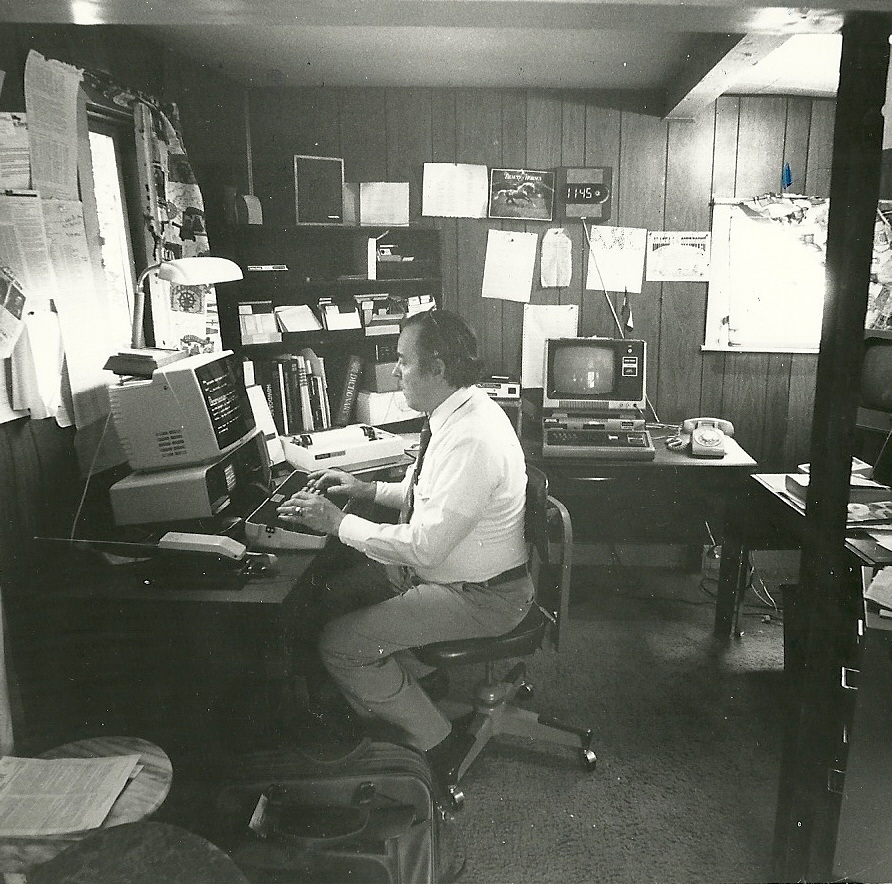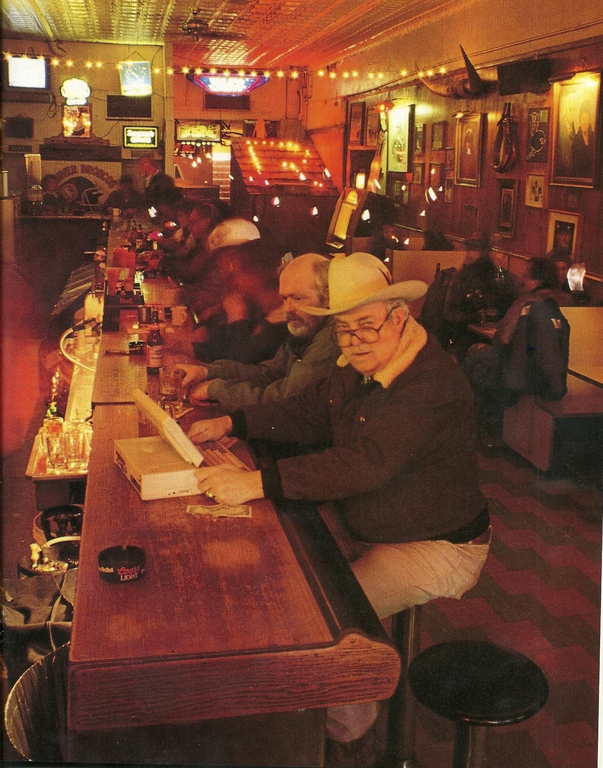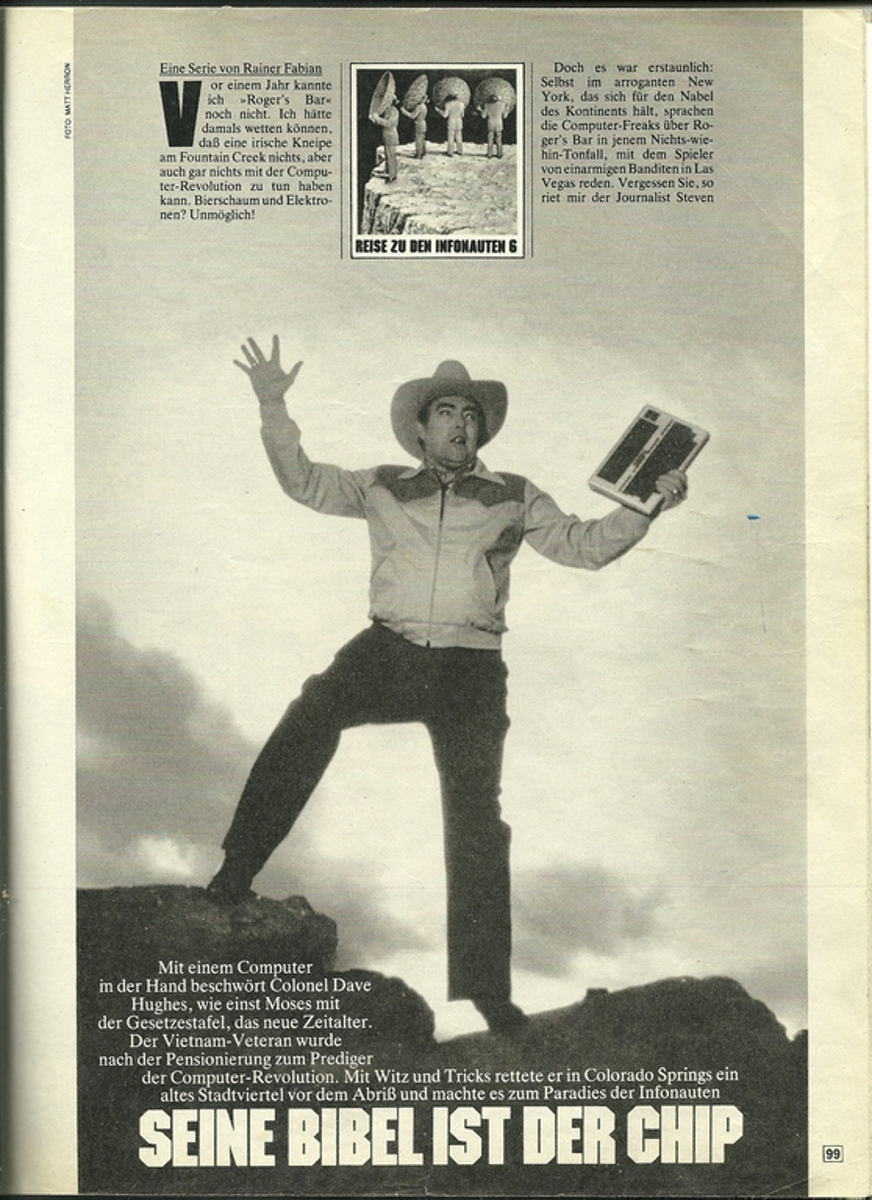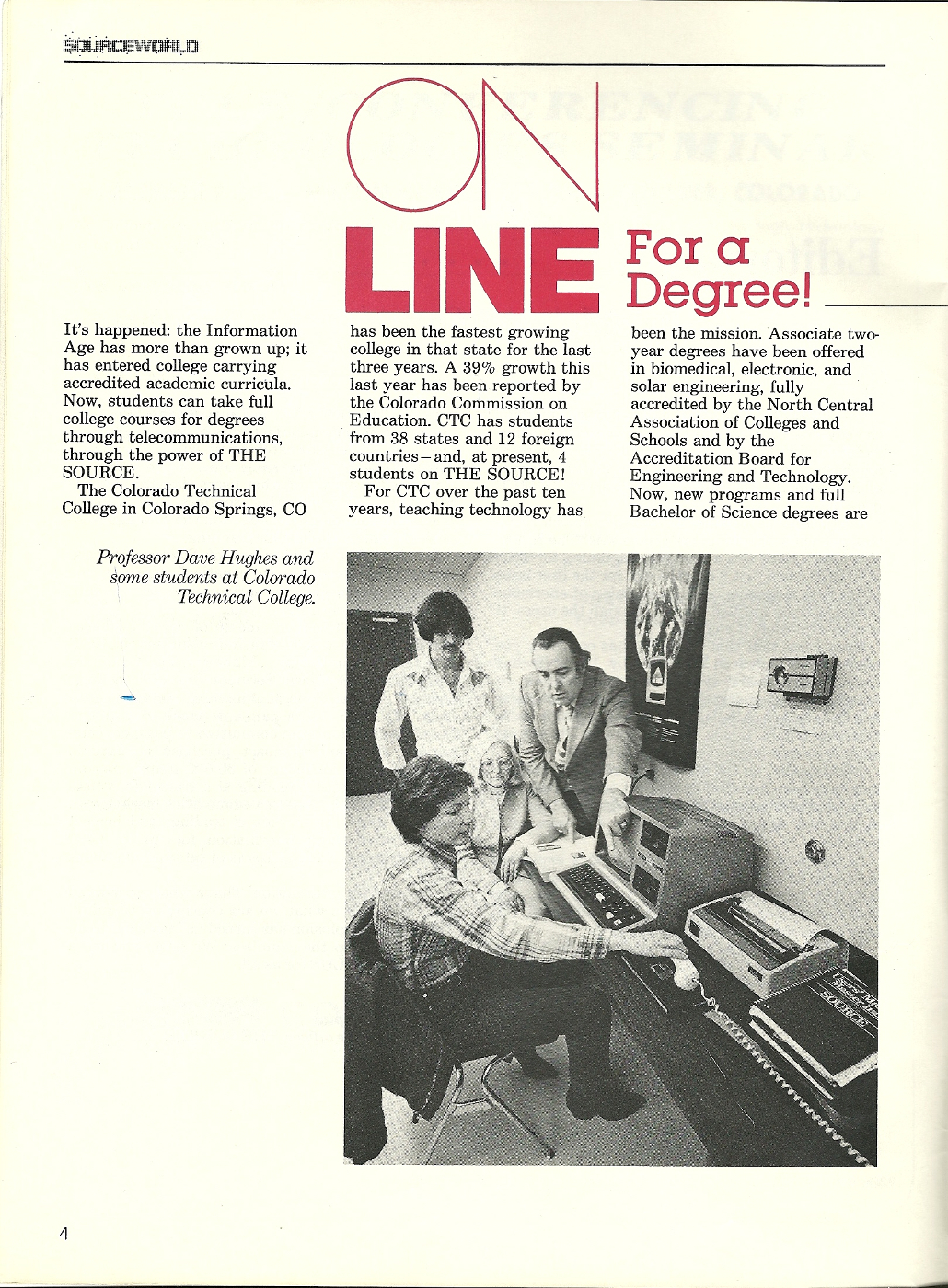Inspired by Future Shock and Old Colorado City's Rebirth
A whole complex of new ideas and innovations burst forth in my mind as Patsy and I decided to move to the West Side of Colorado Springs just one block from Bancroft Park and emerging Old Colorado City in 1977. I had studied 'Future Shock' and 'Megatrends' at Fort Carson which helped guide developing an All Volunteer Army. Now it was time to apply it to a run down part of the City.
Besides trying to make the commercial district on West Colorado Avenue come back from 50 out of 100 totally empty buildings into a new 'Old Colorado City' starting in 1975, I wanted to harness the new 'personal computer' technologies that had just been invented in the Apple II in 1977 and Radio Shack Model 1 microcomputers a year later.
Just as I was being asked to represent the Westside businessmen before City Council I had bought my first Radio Shack Model 1 "Trash 80" personal computer. And found, first, a simple program called 'Electric Pencil' that was an effective text processor. I got a technical guy to open it up and put a switch in that accessed the Z-80 Chip, the main processor, that enabled lower as well as upper case typing, display, and printing - for 'normal' writing. And I was a writer whatever else I was. (I refused to buy the first Apple II because it was upper case only, 40 characters wide, for Jobs and Wozniak thought the only use it would be put to would be computer programming - not things like writing. Jobs wasn't as visionary from the beginning as his devotees have made him out to be.)
When I saw my first upper/lower case lettering appear on the screen with Electric Pencil on my Radio Shack, which - I could correct by the backspace key - I exclaimed outloud "Backspace and Blot out will be a Revolution in the English Language." And it has been.
Then I found a Radio Shack version of 'Visicalc' - the first ever interactive Spread Sheet. Which clearly would be useful to me doing budgets, making economic projections, and even lists of Old Colorado City businesses.
But then I pursued, and soon found what I thought would be the MOST significant value of a personal computer - the ability for an individual to connect up with other PEOPLE over telephone lines by two way written TEXT, not just voice, or slow boat paper mail. I got an early Acoustic Modem. One held cups to the phone speaker and mouthpiece. Over plain telephone letters one could type-send and receive typed words, so long as one was connected by dial up to some 'service' - probably a business. Or directly to the computer owned by a distant person who connected it up directly over a telephone line.
But I also learned about the earliest Hayes Micromodem, that plugged directly into the computer at one end and the telephone jack at the other, using an RJ11 connector to the telephone at one end and an RS232 serial connector at the other end.
The Source
Then I also very quickly learned there was a NEW telecommunication business called 'The Source' (before even Compuserve) that was in the Washington DC area, could be contacted by modem at 1,200 baud modem speed through either locally accessible business 'Telnet' or 'Tymnet' data lines used by business (and government during the business day) connected across the country, paid for by a personal account and a per minute charge. A 'personal' telecommunications service. One could be given an ID (mine was TCE054) with which to send and receive private messages stored there on the server. But could ALSO post, read, and respond to public comments on a string of messages on various subjects. An open forum, discussion place. Multiple persons all connected to the same 'conversation.'
THAT I recognized was a coming global revolution in human communications -people owning cheap personal computers connected to each other - one to one, many to one, or many to many, over telephone lines by modems. In written English.
The Computer Bulletin Board World
As I began to communicate with a handful of strangers via the Source - including ex-Alaskan Lt Governor 'Red' Boucher' reaching the Source from Anchorage - and started posting essays and my thoughts, and even bits of verse about this revolution in the discussion sections of the Source, I learned about the first personally owned computer 'Bulletin Board' - created by Ward Christensen and Randy Suess in Chicago which went online February 16th, 1978.
Now a Bulletin Board was a small Personal Computer - rather than a corporate large computer, like the Source needed - with interactive 'BBS' software running on it, connected to a Hayes 1200 (or comparable) modem set up to 'answer' the telephone if its number was dialed, so it would send out a data tone which, if the calling computer using a modem connected to a 'Terminal program' in its computer was set to listen would 'lock onto' the other modem, and the caller could read what the 'BBS' spit out - usually the name of the BBS, and a 'log in' or 'registration' screen. After which the caller could read what was on the 'BBS', register, leave messages, read messages, and hang up. At first all BBS could only handle one caller at a time. And the only cost was the telephone charge if long distance, nothing locally.
Now I saw immediately that I could have my OWN BBS in Old Colorado City, which outsiders could call, and learn about, not just me, but about Old Town and what it offered, such as loans for small business.
But I had to get BBS software. There wasn't any for sale yet. But there was already computer code for a Radio Shack on Randy Suess 'BBS'. To get it I needed some way to transfer the binary code over the phone-modem line. Well, Ward Christiansen had actually used the BBS created by Randy so Randy could receive binary code programs from another computer including from Ward's over a telephone line. So Ward wrote a program called X-Modem, which would transfer, byte by byte, the code he wanted to send to the receiving computer running X-modem also.
I needed that, but I asked Ward to send me the lines, in 'Basic' programming language of his free code for the xmodem program as plain text, which I could then save and 'Compile' in my Radio Shack's computer 'basic compiler', which turned it back into its binary form which could run on my machine. He sent it to me, and I compiled it into working code.
So I had X-modem, and was able to 'download progams by 'X-modem' running on any other BBS running X-modem. By this time in 1979 there were hundreds springing up across the land) One could transfer other 'programs' not just text - even Visicalc files. I fetched a BBS program by Xmodem from another hacker in California, which was better for my intended use. And set it up. It worked, and I had a dial in BBS. This was early 1979.
After mastering its tricks and getting several local computer-modem owners to dial in, I saw what was needed. So I tracked down in Denver an engineer who worked for Martin Marietta who had developed a BBS program called TBBS as a hobby. It was flexible, and very configurable, permitted registration by callers, sections for different running topics, was stable, supported Xmodem, and later could handle more than one modem and phone line at a time. And it was reasonably secure. He gave me the first versions so I could 'test it' for him - before he started to sell it commercially.
EIES
I also found another online system - which, as one could expect - ran in a higher education academic institution - the New Jersey Institute of Technology. What made that system - named EIES - Electronic Information Exchange System special was that its designer - Murray Turoff with his wife - Dr Roxanne Hiltz wrote an early (1978) landmark book 'Network Nation' - which, under a National Science Foundation Grant - studied the 'pattern' of usage and probable future of data networks with personal computers in homes. A radical idea at that time. It first raised the possibility online networks could have widespread educational applications.
Even though EIES was a limited-access system, doing research work under a series of grants, my spreading fame persuaded Turoff and Hiltz to give me access to the system. Which gave me access on the very first US System that exchanged scientific research messages with Russians in Moscow.
It was on EIES that I first wrote
***** DANCE OF THE RED LEDS *****
Electrons vibrate for Poets,
Mehitabel,
Not Programmers.
In the Grim March of Hex
GOSUB minds
Build trellises
Of Logic
So spare they whistle Electric Winds
Enough
To chill my human heart
Lovers must touch the Glass of Phosphor
With hands limp and graceful as
The Michaelangelo;
To summon up the Passionate symbols
Else bytes will warm the bankers only
Do not the luminous dots ache for
The Backspace of Genius
And The Dance of the Red Leds?
There have been others, Mehitabel
The fashionable Mosaic Makers to the
Emperors of Byzantium
Worked their Craft in Plates of Color
That arched to the sky
In the Temples of the East
Pleasing the plump tourists
But those who know what delights
A young girl's eye think
The Glass Buttons found in the street
Were best
Dreamers of the street made designs
On the ordinary ends
Of a thick bundle of glass rods
Then drew the glass cylinder
Firey hot into a fiber
Oh! so delicately fine that
When cut and polished the
Fragile slices made
The most exquisite mosaic art of all
Few knew what fusion of Art and Tech it
Took in that ancient city.
Or the number of dark eyed beauties
Who surrendered
To those miniature chips brought by
Impecunious suitors.
When ASCII is for artists, Mehitabel,
Leds will be for Lovers, and the
Troubadours
Of Technology
Will bring Grace to us All.
:::::::::::::::::::::::::::::::::::::::::::::::
Copyright, 1981
David R Hughes
Writ Somewhere out in Electronic Space
All the while I was reporting all these things on the Source, to a growing audience, not as much hackers as professionals, who seemed to like my Information Age philosophizing.
I was spending lots of money dialing into the Source, even exchanging information about how to revive an Historic district. I also logged into another national Service, called Compuserve, owned by H&R Block. It had more technical users and handled technical issues better than the Source, and had many more useful 'programs' and utilities which other users had 'uploaded.' I could, using Xmodem download and use them. There was lots of 'sharing' online in those days.
The Old Colorado City Electronic Cottage
It had been, mid 1979, that I launched the 'Rogers Bar' BBS. And installed it in the actual cottage - 6 1/2 N 24th Street we owned behind our main house at 6 North 24th Street
Even though there was the early Source, and Compuserve, - they connected up people who had to pay a subscription and online fee. How about a 'free' network?
THIS small building, built in 1894 as a 'TackHouse' to house a horse and carriage, became THE famous 'Old Colorado City Electronic Cottage'
Toffler in Future Shock and the 3d Wave used the term "Electronic Cottage' which was apt. Here was mine.

I installed a second Radio Shack (Model III this time) its own phone line, TBBS software, a printer, and it became the FIRST computer Bulletin Board in all of Colorado Springs. Thom Foulks had the second.
Electronic Democracy
And it was primarily dedicated to the purposes of Electronic Democracy. One section was called 'Rogers Bar' - for the actual Rogers Bar in Old Colorado City two blocks away was always the place that Democratic Westside Union Politics were debated.
I became the defacto 'Electronic Bartender' - who kept peace, moderated discussions, and posted LOCAL issues worth debating online. It was not IN Roger's Bar, but ABOUT the political discussions that took place there.
I had thought hard about the American political process. That seemed to me had three components - first the distibution of information or issues to the public. Newspapers books, magazines and television did a credible job doing that. And in the end, individuals cast their ballots or took action. But in between Americans had to Discuss, Debate, Argue, Listen to others, and finally Decide, before casting their ballots. And through such debate, asking questions, expressing opinions they make up their minds.
What the Electronic Democracy Bulletin Board could do was foster and encourage the vital DEBATE phase of the democratic process. For it linked INDIVIDUALS to each other ASYCHRONOUSLY (not just in real time) - not just to institutions, or just let 'News Anchors' or 'experts' or candididates tell them - in one way slick ads - what to think. Before my BBS, (and then much later what are called 'Blogs') most individuals only discussed political issues and matters with a small local, face to face circle - family, friends, maybe at work. The rest of the time they were beseiged some could say brainwashed - by mass media.
But now, close by or far apart - and as direct question and and answer as one would want - and with a minumum of inconvenience travelling to meetings. people with just a personal computer, a modem, and a connection - a telephone or data line - could 'meet' online.
Below is the Story of how I challenged - and won - a political battle at City Hall by use of my Electronic Cottage BBS. Published in Whole Earth Review. Click on it as a PDF file.
Story of Challenging City Hall
In fact a small newspaper publisher who took a formal course - 'Electronic English' from me later summed it up perfectly. "Roger's Bar BBS is the New England Town Hall Meeting over an Electronic Back Fence in Colorado."
The Impact
The local, then State, then National, then International reaction to my Roger's Bar BBS and the matter of 'Electronic Democracy' was astonishing.
I can only attribute my near instant fame from the combination of (1) being so early as an individual, not instituational, user of online communications - my BBS (2) my vision for its possibilities (3) using it for practical grass roots political discussion and action (Rogers Bar) and education (Lil Red Electronic Schoolhouse) (4) my colorful persona (Cursor Cowboy) (5) my online - even poetic - Story Telling skills.
And my being so visionary may be from my descendency from 11 generations of Welsh ministers. My Celtic ancestors could look over the horizon and see 'little fairies' coming out of the ground. I could see, before anyone else, 'bits and bytes'. I have always been years ahead of everyone else. While Engineers knew 'how' computers and communications links worked and could work, I always knew 'why' they could be used in the individual, very small group and public interest - regardless of the distance between them.
Somehow the idea of a 'Cowboy' empowered by a personal 'Computer' instead of a Colt revolver resonated with the myth of American pioneering and frontier West.
In short order what I did made local newspapers and television, and especially spiked after I used it to support the election of an unknown City Council candidate whose independent positions I liked, over a well known College Professor who was purportedly a national expert in local elections, but who only used traditional television and newspapers and meetings. He was defeated by less than 100 votes over 2,000 cast. The difference? People got to know Wayne Fisher by talking to him online via my BBS.
Having heard of it, the Wall Street Journal flew out to Colorado Springs to actually go into my Electronic Cottage, sit down at the keyboard and chit chat with persons unknown. The reporter had never seen a 'BBS' before. He got it. And I made the front page of the Wall Street Journal.
 |
People, and Journalists flocked to Old Colorado City - having logged in online to the BBS in the Electronic Cottage, they also wanted to visit down home, western flavor Rogers Bar too. For by this time I could log into the BBS via one of the bar's telephones, with a Model 100 Radio Shack handheld computer with a built in modem.
The idea of going online from a colorful neighborhood bar struck people as something as far away from Techie computer nerdism as possible.
|
Prestigious Wired Magazine in its 'high tech culture' Silicon Valley second issue - 1993 - made that BBS the featured story. Focusing on me the 'Cursor Cowboy', the BBS that was in my Electronic Cottage, and Rogers Bar. |
 |
Besides the Wired Magazine article, the talk about my version of 'Electronic Democracy' on he Source caused the story to spread far and wide - Governing Magazine, several Sunday Supplements, featured the idea and my BBS.
Stern Magazine from Germany flew in to feature me and photograph me and Old Colorado City as well as the phenomenon - as they saw it, of Electronic Democracy.

Suddenly I was in high demand.
The Japanese learned about me, through Lisa Carlson (Kimball later) and Frank Burns MetaNet. So I flew to Sendai,Japan with others of like mind, and I presented the ideas and implementation of 'Electronic Democracy' Bulletin Boards to over 400 in the audience. Soon afterward two Japanese journalists came to Colorado to see me and 'Rogers Bar BBS' and went back to write a piece, with photographs. It was pubished in the Youmuri Shimbun Tokyo newspaper - with 15 million daily readers.
Saveral other things happened in rapid succession.
First of all the President of Colorado Technical College (later 'University) visted my BBS in the Cottage and asked me to teach for a time at CTC its students what I already had dubbed 'Electronic English' (and I don't mean 'word processing.') So I designed a course which involved using the Source to link remote students with ones who came to class in Colorado Springs. It was a hit. Local School District teachers wanted to take it. The Publisher of the long time Manitou Springs 'Pikes Peak Journal' took it. Tech students at CTC took it. And most amazing of all, ex-Lieutenant Governor of Alaska - 'Red' Boucher' took it from Alaska, via the Source. For College credit! The idea of 'distance learning' took off. My daughter Rebecca took it - and from learning how to use, and communicate data to and from, Visicalc spread sheets - started her career doing business accounting.
My teaching, for College Credit an 'online only' course became the first use of digital telecom for formal University education in the world.


By the time I had been using - and paying for - The Source more than any other customer, and seeing the large number of other Source users flock to my discussions "Through the Electronic Void" I called up Source Management and said "Since I not only pay for my use of your service, but all those other customers of yours pay for their use too reading MY stuff, I think you should pay me a Royalty for my "Electronic Publishing' which is very popular and more popular than the 'personalities' - like Jane Fonda - you have paid to go online to attract users.
They agreed and I started getting 17% of the billed time other customers spent reading MY online journal. A pioneering venture. Some reported that Dave Hughes invented 'User Publishing' on national networks.
Discovering Me in Silicon Valley - 1984
After the 1st Hackers Conference - which became an annual affair, all of which I had been invited to attend by Stewart Brand (creator of Whole Earth Catalog series) - woke up some leading hackers to what I was doing, and why, followed by noteriety of the Roger's Bar Electronic Democracy, the Wall Street Journal column, the Sourceworld Magazine (in house Source Journal for all subscribers)
There were so many writers, reporters, and researchers who read my stuff or about my activities AND communicated with me or researched what I was doing, that I became a symbol for the newfound power of individuals equipped with the new personal computers and telecommunications networks. I appeared in newspapers, magazines, articles, and landmark books, such as one by Howard Rheingold "Virtual Communities" Masters' Thesis by Annenburg Foundation Scholars, Doctorate Thesis in at least one Florida college, Boardwatch Magazine, Byte Magazine, Popular Computing and others. And there were serious reviews of the implications of 'electronic democracy.' Governing Magazine, the FBI Telecommunications Conferences, the Electronic Frontier Foundation, as well as their foreign counterparts sprung up. Even a family member of a Supreme Court Justice (Breyer) wrote an article on me.
After an Educator at the Montana Teachers College in Dillon, Montana, Frank Odasz, logged into my BBS repeatedly, then flew down to Old Colorado City to see me - he landed a Grant from US West to teach teachers from the over 100 one-room schools in Montana, entirely online. The large telephone companies suddenly got very interested in what people were doing over their telephone lines. US West, in particular, took a keen interest - more from what using their lines - often free of tolls - was doing to their business model. On one Mother's Day, Pacific Telephone company was brought to its knees from overload use of their voice circuits by modem users on top of their usual Mother's day voice calls.
Big Sky Telegraph which sparked a revolution in 'distance learning' - in Montana first by the teachers, then their students began to spread through K-12 school districts and universities. It was based, technically, on a combination of Fido (store and forward) BBSs and UUCP links at the university level - to connect around the world, going Fido Net locally.
It came time to close down the Enjoy Colorado 'information service' on the near Westside of Colorado Springs, even stop using the Electronic Cottage and its BBS, and start up Old Colorado City Communications as a serious business with my own Unix Server connected to multiple phone lines and a dedicated data line to the rest of the World.
And go into a serious computer communications and conferencing business, as well as accept contracts to help schools, businesses, and governmnet agencies start to use the power of personal computers and telecommunications.
Go onto Old Colorado City Communications

